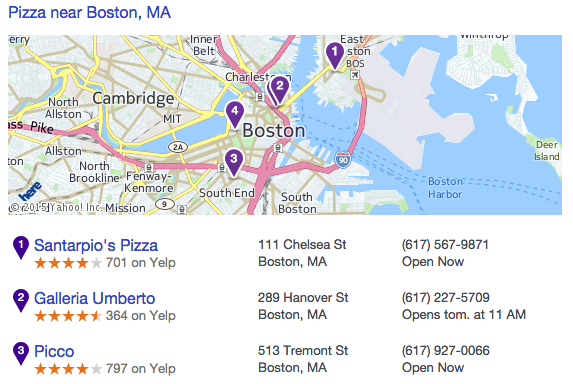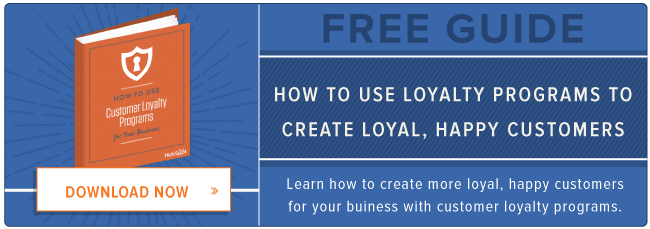
We (and the rest of the internet for the past decade) have already spent some time convincing you of the importance of acquiring online reviews for your business. So let’s just assume you’re sold on the benefits of having a bunch of people tout how awesome you are on the web.
That being said, it’s not safe to assume we all know exactly where in the wide world of the web we can point those well wishers when they want to sing our praises. I mean, we might all be able to rattle off one or two sites (“Yelp! And I think you can get them to show up in Google Maps, too?”), but we don’t exactly have a laundry list of options at our disposal.
Check out our list of the best product review websites for B2B and B2C companies. Keep in mind that every industry has niche sites, too. For instance, those in the restaurant industry may want to be on UrbanSpoon. This blog post won’t get into sites that are specific to one industry, but it will provide review sites that apply to businesses in almost any industry.
Download our free guide to customer loyalty programs here to learn more about how to create loyal, happy customers.
Review Sites for B2C Companies
1) Amazon Customer Reviews
Amazon was one of the first online stores to allow consumers to post reviews of products in 1995, and it remains one of the most important resources for consumers looking to make informed purchase decisions. Even if people can and even do buy a product elsewhere, if it’s sold on Amazon.com — unless it’s gasoline or drug paraphernalia, that is — then many people will look up its Amazon review before they decide to buy.
What’s going to separate your product from one that looks just like it? Those shiny gold stars and good customer reviews. Products are rated on a five-star rating scale, which is broken down by percentage of reviews per star, followed by most helpful customer reviews and most recent customer reviews.
2) Angie’s List
Geared toward U.S.-based service businesses, Angie’s List is a “higher-end” review site, because users actually have to pay for membership. But you get what you pay for. The reviews, given on an A–F scale, are typically very well-thought out — not a lot of that ranting and raving that’s more common on free review sites. The reviews can’t be anonymous, which helps cut down on fake or misrepresentative reviews, and companies are allowed to respond to the reviews posted about them, too.
It’s free to set up a page for your company. Once you have yours, encourage your customers who are on Angie’s List to leave reviews there — members are the only ones allowed to do it!
3) CHOICE
CHOICE is kind of like the Angie’s List of Australia. It’s a paid customer review website. In addition to allowing customer reviews where people can rate and discuss specific brands and models with other CHOICE members, they also test products themselves, create product comparisons, and write buying guides. If you have customers in Australia, we recommend encouraging those who are on CHOICE to leave reviews there.
4) TrustPilot
Have a customer base in Europe? TrustPilot is a fast-growing, community-driven consumer review platform based in Denmark. They have two complementary review types: product reviews written by customers and seller reviews written by folks at the companies selling those products. The platform for businesses helps companies from all over the world proactively collect customer reviews.
While they have a basic version for free (this lets you create a profile page and collect customer reviews), their paid versions let you create customizable review invitations, share ratings and reviews on social media, and link review data to your internal business systems.
5) TestFreaks
Similar to TrustPilot, the Swedish-based TestFreaks helps companies proactively collect customer reviews and write seller reviews to complement them. Another cool addition? Their question and answer feature, which lets prospective customers post questions and receive answers directly from your customer service team.

Image Credit: TestFreak
6) Which?
Which? is an independent consumer review organization that tests and reviews products and then writes about them. Unlike Angie’s List, it’s the folks at Which? who write the reviews — not the customers. They don’t accept submissions for product testing or survey inclusion, but they do encourage people to let them know about their products and services by emailing brcpress@which.co.uk.
While this leaves less room for you to influence whether your products end up on their site, it’s still worth knowing about and checking in on this popular site, especially if you have customers in the U.K. The website has product reviews for everything from dishwashers and tablets to cars and credit cards. They test and review all these products themselves, and then write about both their methodologies and results. They also take customer surveys of things like the best and worst firms for customer service.
A lot of their content is free, but customers can become members for £10.75 per month to get access to a “Best Buys” and “Don’t Buy” list, the latest reviews of products from their test labs, and access to their consumer legal advice service.
7) ConsumerReports
A nonprofit organization, ConsumerReports is an independent product testing organization that runs unbiased tests to rate and recommend products. They’ve reviewed over 7.7 million products, accept no advertising, and pay for all products that they test. (Fun fact: They buy and test 80 cars per year!) This is about as legitimate as it gets. As such, there’s not much you can do here “except” if you sell a product, make sure it’s really, really good.
If nothing else, you could take this website as a lesson in excellent content creation. For each product they review, they provide the review criteria, product overviews, a buying guide, and social sharing buttons. It’s all quite comprehensive and, well, helpful. Pretty much the key to great content, am I right?
8) TripAdvisor
If you’re in the travel, hotel, airline, entertainment, or restaurant industries anywhere in the world, you’ll want to check out the reviews on the popular website TripAdvisor. As the largest travel site in the world, it has over 225 million reviews, opinions, and photos taken by travelers. They also have some awesome content on their about low airfares, travel guides, rental listings, and advice forums about pretty much every location in the world you could possibly image. A lot of people look there before making a trip.
The key to a successful profile on TripAdvisor is making it as close to the top of their popularity index as possible, so that people searching for information in a specific place see your listing. According to TripAdvisor, the popularity ranking algorithm is based on three key components: quantity, quality, and recency of reviews. Here’s an excerpt of the advice they give businesses looking to improve their ranking:
Quantity: Ask your guests to write reviews, and use our management center tools to remind them after they check out. Offering incentives for reviews is against the rules, though — take a look at our policy to make sure you understand what is and isn’t okay.
Quality: Guests who enjoyed first class hospitality and a memorable experience are more likely to write positive reviews. Monitor what previous reviewers have written to see what worked and did not work best for your property so you can maintain and improve your service.
Recency: Recent reviews factor more strongly on your popularity rankings and older reviews have less impact on a hotel’s ranking over time. Once again, encourage guests to write reviews to keep fresh content rolling in.”
9) Yelp
Yelp is a free review site that lets consumers rate businesses on a five-star scale. Any business can set up a profile on Yelp for free, and users can set up their own free profiles to review a business. You’re free to respond to reviewers, too, but we recommend taking a balanced and polite approach to any negative reviews you receive, as Yelpers are in a pretty tight-knit community.
Yelp has also come under fire over the past few years for some slightly shady practices, like incentivizing businesses to advertise with them in exchange for gaming the search results for their business (“Pay us money and we’ll push bad reviews down!”). Savvier consumers have learned to look at Yelp reviews as a whole and with the reviewer’s clout in mind, instead of getting turned off by a business because of one bad listing.
That being said, it’s still to your benefit to get a constant stream of positive online reviews coming to your business’ Yelp account so happy customers are always at the top of your review feed — especially is you’re a location-based business. Yelp profile information contains things like store hours and location information, so your profile will often turn up when people Google your business.
10) Google My Business
You know those reviews that show up with you search Google for a business? Yeah, those things are on this list in a big way.
Google’s Pigeon algorithm update uses distance and location ranking parameters to deliver improved local search results. So, in order for your business’ website to be properly optimized for search, you’ll want to set up verified accounts with local directories — especially Google’s, called Google My Business. Getting reviews, comments, pictures, and so on, especially on Google, can give you a boost in search. Only verified local Google+ pages can respond to reviews.
An added bonus? Google Maps pulls that information and those reviews into the app, so having a lot of content in there will make your business look more reputable.
11) Yahoo! Local Listings
Similar to Google My Business reviews, Yahoo! Local reviews let users post reviews of businesses with a five-star rating system. Here’s what the results might look like:

According to Search Engine Land, Yahoo! still receives about 10% of search engine share. So while you might not want to invest time figuring out the intricacies of Yahoo!’s algorithm, obtaining some favorable reviews on the Yahoo! Local Listings sure couldn’t hurt for that 10%.
Review Websites for B2B Companies
12) G2 Crowd
If your business sells software, you’ll want to be sure you have a presence on G2 Crowd. Every month, over 300,000 people looking to buy software read the 37,000+ user reviews on this website so they can make better purchasing decisions.
G2 Crowd operates kind of like Yelp, but in a specific niche. Companies are reviewed on a five-star scale, and reviews cover everything from setup and easy of use to security and support. Reviewers answer questions like “What do you like best?”; “What do you dislike?”‘; and “Recommendations to others considered the product.” Also, you can upvote and downvote others’ reviews.
13) TrustRadius
Like G2 Crowd, TrustRadius is an online review site for software businesses. Reviewers on the site are authenticated via LinkedIn to make sure they’re users (although the reviews themselves can still be anonymous), which allows users to see what their LinkedIn connections are saying about particular pieces of software on TrustRadius. This adds a layer of trust for someone reading the site.
You can use the site to browse reviews of individual companies, or compare two companies side-by-side to compare their five-star ratings, screenshots of their products, pricing details, and user comments from reviewers.
In addition to their company reviews, they’ve put together a whole bunch of buyer guides for categories including talent management software, business intelligence software, core HR software, social media, and A/B testing to help people find the right product for them based on hundreds of reviews and user ratings.
14) Salesforce AppExchange
Have an app on the Salesforce AppExchange? Then you’ll want to keep track of your app’s ratings and reviews there. Reviews are based on a five-star rating system, and each app has reviews listed with the most helpful positive review and most helpful negative reviews first, followed by all reviews, from which users can filter by rating, date, and helpfulness. They’ve embraced transparency, letting users access thousands of reviews and see the number of downloads with just a few clicks.
For Online Reviews Both B2B & B2C
15) Better Business Bureau
A nonprofit site, the Better Business Bureau (BBB) evaluates all types of businesses against a set of best practices for how businesses should treat the public. They don’t directly recommend or endorse any businesses, products, or services; they simply provide the public with the information on their site about businesses, and whether they have met the BBB’s accreditation standards. They will also review both accredited and non-accredited businesses.
A business’ profile listing on the BBB contains general overview information, like a short company bio and the company’s accreditation status, a history of any complaints made about the business and whether they were resolved, customer reviews, and the BBB’s A – F rating of the business.
16) Glassdoor
Glassdoor is an employee review site that helps anyone — from prospective employees to prospective customers to investors — get an idea of what a company is really like from the inside. In other words, it helps measure the more qualitative factors of things like valuation.
Employees can share what it’s like to interview and work at their companies, and the site shows visitors which companies are rated highest by their employees. Many employers use it to build their employment brand so they can target and recruit candidates, but you can also use the reviews to share ideas internally for improvement among your management team.
Creating an employer account is free, and it’s easy to track and respond to reviews. For example, you can set up alerts so you get an email each time a new review is posted so you can acknowledge and respond to each one.
Other Places for Consumer Reviews
Online reviews also exist on sites that aren’t necessarily built just to publish online reviews. Some businesses use their social presence and website to encourage online reviews … and some brands just get them unsolicited, for better or for worse.
Here are some sites that, if you choose to (please, choose to) can serve as additional hubs for online reviews. And they’re awesome, because they have enormous reach, and you have some — if not entire — control over these properties.
17) Facebook Ratings & Reviews
Did you know there’s a place on Facebook for fans to leave ratings and reviews of your business? There sure is … it’s named, aptly, Facebook Ratings & Reviews. It appears on the left-hand side of your Facebook Page, and you can’t move or remove it like you can other parts of your Page.
Anyone logged into Facebook can post a rating or review of a business. All they have to do is go to the Reviews section of your Page, click the grey stars to choose a rating, and then write an optional review. They can make that review public, visible to friends, or visible only to them.
18) Twitter
The ridiculously fast-paced nature of Twitter makes it seem like a weird place to try to accumulate reviews. But while users might not always search for reviews directly on Twitter (unless you started some kind of review hashtag, perhaps), tweets are still indexed in search results. That means a user’s tweet, whether complimentary or less-than, could pop up in the SERPs when someone’s searching for reviews on your business.
Not only that — there’s things you can actively do with the positive tweets coming at you. For instance, we tested the element of social proof on conversions here at HubSpot, attaching three tweets that gave positive reviews on an ebook we were promoting at the time. Guess what happened? The CTA with the three tweets converted better than the CTA with no tweets. If you start to “Favorite” tweets that could serve as positive reviews in the future, it’ll be easier to find them when you want to use them in your marketing.
19) Your Own Website
Finally, the one place where you have total and utter control: your website. It’s an excellent place to publicize reviews you receive (perhaps embed some of those tweets you favorited?) You could carve out a section of your website dedicated just to reviews and testimonials, and even include a form so happy customers can submit their unsolicited reviews. But if you’re actively campaigning for positive online reviews and you encounter happy customers who want to leave you a positive review but don’t have accounts on sites like Yelp, Angie’s List, or Google, it’s handy to have a place on your website to publish their kind words. Consider adding testimonials to landing pages and product pages, too.
What other online review sites do you use, either as a marketer or consumer? Share your ideas with us in the comments.
Editor’s Note: This post was originally published in October 2012 and has been updated for freshness, accuracy, and comprehensiveness.
![]()








